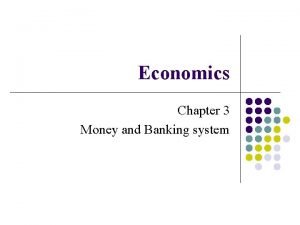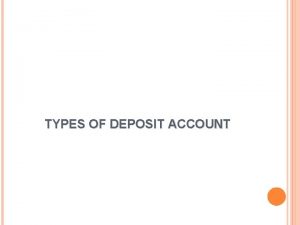Discussion of the paper Deposit Insurance and Deposit















- Slides: 15

Discussion of the paper: Deposit Insurance and Deposit Products Discussant Branko Urošević, Faculty of Economics, University of Belgrade and National Bank of Serbia Moscow, November 9 th, 2012

Deposit insurance and market discipline • Vast theoretical and empirical literature exists on relationship between deposit insurance and market discipline • Dybvig and Diamond (1983): deposit insurance may prevent bank runs in a socially-optimal way • Demirguc-Kunt and Detragiache (2002): DI can lead to increase in risk-taking by banks and reduction of borrower incentives to monitor banks, thus reduction of market discipline • DI creates less problems in countries with more developed institutions and market info, more problems in emerging economies

Market discipline in emerging markets • Market discipline: quantity and/or price impact • Caprio, Honahan (2004) argue that market discipline can work even in unsophisticated mkts provided: – Products not complex – Significant presence of foreign banks – Money in smaller number of hands • Calomiris, Powell (2001): market discipline worked in Argentina (written prior to the collapse) • Examples from Poland (Mondshean, Opiela (1999), Latin America (Martinez-Peria, Schmukler (2004))

Case of Russia • Russia provides an interesting lab to study these issues since: – Three large scale banking crises in 1990 ies alone – From 2004, government DI scheme introduced and became obligatory for banks that accept retail deposits • Chernykh and Kole (2011): show that DI helped develop Russian banking industry (through increased confidence) but also increased moral hazard behavior • Karas et al (2010) for pre DI Russian mkt: evidence of quantity-based market discipline, no evidence of direct price-based discipline (argue, however, that depositors view increase in interested rates offered as a risk measure, thus reduce volume) • Ungan et al (2008) for early stages of DI: evidence of quantity-based market discipline, no evidence of price-based discipline; ambiguous effects of DI on risk taking • Peresetsky et al (2007): 26 banks (Sberbank excluded), 2004. Studies pricing of both RUB and foreign currency deposits. Different determinants (conjecture that foreign currency depositors more sophisticated).

This paper • Studies retail deposit market in Russia in the period April 2011 -February 2012 • Collects almost 80, 000 deposit contracts across 371 most active Russian banks (state, foreign, and private Russian banks) • A complete set of deposit contract features • Collects various standard bank-level characteristics • Looks at determinants of pricing retail RUB deposits including how deposit insurance may influence pricing

Main results • Shows that Russian banks offer sophisticated deposit products • Product additional features mostly priced in (and need to be taken into account by regulators). • From univariate exploration: – Uninsured (or rather partially insured) deposits (higher than 700, 000 RUB) have about 70 bp premium, on average, with respected to insured ones. – Interpreted as risk premium – Banks with high lending activities and uninsured products by small banks have high interest rates

Main results: preliminary regression analysis • Explanatory variables: – deposit level characteristics: insurance status, deposit size, maturities dummies, 12 indicators for various options – bank level characteristics: regulatory capital ratio, NPL ratio, private loans to assets, banks size, household to total deposits • Dependent variable: RUB deposit product interest rate

Main results: preliminary regression analysis • Collapse 11 months of data into a cross section • Key findings: – Uninsured dummy positive but barely significant for the overall sample, significant for private domestic banks and especially for aggressive deposit taking banks – More capitalized banks offer lower rates for uninsured products than less capitalized banks (see a comment below, however); No such effect for insured products – Less competition (regions), foreign, state banks –> lower rates

Main results: preliminary regression analysis • Key findings in aggressive deposit growth segment: – Higher risk measures -> higher deposit rates on fully insured deposits. – Can be interpreted as mkt discipline at work. – Also, can be that riskier banks exhibit moral hazard. – The latter confirmed by the fact that higher proportion of household to total deposits leads to higher rates in fully insured contracts (and not in uninsured ones)

Main results • Uninsured contracts more sensitive to bank level risk than insured ones • Aggressive deposit taking banks offer high premium to compete in insured market • They conclude that ratio of insured to total deposits may be a good proxy for bank risk profile (see discussion below)

Comments, issues, suggestions • Overall, a very promising piece of empirical research • An impressive undertaking in terms of data collection • Not complete (missing part on quantity market discipline, literature review, conclusions) • Results and conclusions make sense to me. One possible caveat: – Table 4: banks in upper quartile of regulatory capital ratio offer significantly higher interest rates than those in the lower quartile for insured products and not significantly different for uninsured – does not seem to fit with the rest of the story and the results of the regression

Comments, questions, suggestions • Uninsured deposits are in fact larger than insured ones • Depositors of larger amounts can demand higher interest rates no matter the bank risk. • Premium may be, at least in part, deposit sizerelated • Perhaps dummies to check if the effect stronger for larger deposit size brackets

Comments, questions, suggestions • Proposed bank risk measure, ratio of insured to total deposits, implies potentially stronger market discipline (Caprio, Honahan (2004)) -> smaller credit risk • However, is having a small number of large (uninsured) deposits less risky than having a lot insured ones? • Not necessarily since exit of a few large depositors may cause trouble -> higher deposit concentration/liquidity risk

Comments, questions, suggestions • Missing clear motivation: up front clearly state why you are doing what you are doing • Household deposits increasingly important source of funds not just in Russia (shifts across Europe) • Thus can be useful for broader European emerging markets • Several novel results -> authors need to clearly outline in the intro what is new and/or different with respect to the literature • More careful policy analysis and potential impact needed

Comments, questions, suggestions • How about foreign currency deposits (for another paper, perhaps)? • Quantity market discipline analysis (to be done) seems like a very important complement • However, is 10 months enough to discern changing risk profiles of banks? • Can consider also some other bank level measures (including liquidity/deposit concentration) in addition to current measures (maybe some of them work better, check the literature) • Correct typos • Overall, great work, learned a lot by reading it. Upon completion, recommend to everyone interested in banking
 Demand deposit vs savings deposit
Demand deposit vs savings deposit Apush
Apush Simple distillation observations
Simple distillation observations Fire insurance introduction
Fire insurance introduction Example of discussion in research paper
Example of discussion in research paper Paper 2 aice general paper
Paper 2 aice general paper Aice prompts
Aice prompts Hát kết hợp bộ gõ cơ thể
Hát kết hợp bộ gõ cơ thể Frameset trong html5
Frameset trong html5 Bổ thể
Bổ thể Tỉ lệ cơ thể trẻ em
Tỉ lệ cơ thể trẻ em Chó sói
Chó sói Tư thế worm breton
Tư thế worm breton Alleluia hat len nguoi oi
Alleluia hat len nguoi oi Các môn thể thao bắt đầu bằng tiếng bóng
Các môn thể thao bắt đầu bằng tiếng bóng Thế nào là hệ số cao nhất
Thế nào là hệ số cao nhất





























